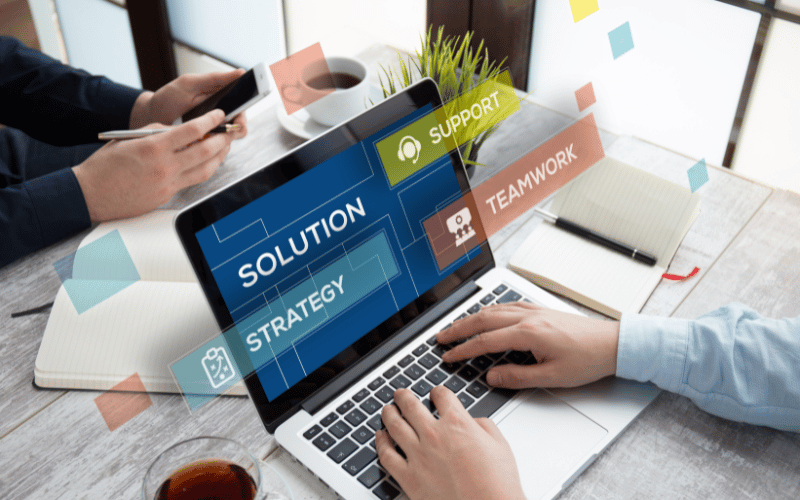E-commerce: It’s not just shopping online; it’s an adventure from click to doorstep. According to Morgan Stanley, the e-commerce market will reach $5.4 trillion by 2026.
Think about the last time you ordered something online. What made the experience stand out? Was it the quick load times, the easy navigation of the website, or how fast your product arrived at your doorstep?
Imagine if managing your e-commerce business was simple and streamlined—from the first spark of inventory purchase right through to the happy customer unboxing their purchase. That’s the power of end-to-end e-commerce solutions.
In the advancing space of e-commerce, not having a seamless process from start to finish may result in a setback for your business. E-commerce solutions act as a well-oiled machine, with happy customers coming back for the experience. It’s about creating a streamlined journey that not only meets but exceeds customer expectations.
Streamlining your business processes can seem challenging, but it’s more about clever shifts than total transformation. In this article, we’ll eliminate the problems and provide you the simple methods that allow you to speed past the competition.
Understanding your E-commerce Process Flow
The magic of a successful e-commerce business lies in its ability to handle transactions seamlessly. Imagine this: a customer orders an important item from your online store. They’re awaiting its arrival, while days turn into weeks, and their time takes more time to arrive than needed. This could be frustrating.
When a customer decides to buy from your online store, the last thing you want is for them to leave at checkout. That’s why this part of your e-commerce flow should be as simple and straightforward as possible.
- Implement a checkout process that asks only for essential information, ensuring it’s swift and hassle-free.
- Offer multiple payment options, from credit cards to digital wallets, to ensure that every customer can buy easily from you, regardless of their preferred payment method.
- Use targeted ads to remind them of what they’re missing, and consider offering a small discount or free shipping to sweeten the deal.
If navigating the complexities of your e-commerce process flow sounds daunting, partnering with a tech-savvy team like Codewave can streamline this for you with our expertise in developing web and mobile applications that cater to various industries.
Here’s how you ensure end-to-end e-commerce solutions for your brand.
Simplifying the Checkout Process
First up, is your checkout process. This is the make-or-break moment for the customer. The glow here is to make sure your customers breeze through the checkout process without a second thought. Think about if you need to know the customer to fill out their birthdays or if you should prompt them to sign up for the loyalty program at checkout.
- A good strategy would be to cut down on the number of fields a customer has to fill during the checkout.
- Aim for a clean and simple design that also guides your customer smoothly from cart to purchase without any confusion.
- Use large, readable fonts and clear action buttons (purchase, add to cart, etc.).
As an example, e-commerce brands and even food delivery apps have started breaking down the ordering process into parts – where customers can decide what they want to order on one page and then proceed to checkout on another page. This reduces the complexity of the whole process and makes the experience memorable for customers.
But, a clean design is not the beginning. When you continuously refine and routinely check the process to ensure customers are getting what they want, it makes a huge difference.
- Are there common points where customers drop off?
- Could a different button color or a simpler form improve things?
Use tools to track user behavior and see where you might be losing potential sales. Keep testing changes to see what works best.
With the front end sorted, it’s time to dive into the back end of your operations.
Optimizing ECommerce Software and Integrating ERP
If you want to smooth out your ecommerce operations you understand how important a software setup is. Using an Enterprise Resource Planning (ERP) system for end-to-end e-commerce solutions may seem daunting at first. But it’s a game-changer to simplify your operations.
ERP Systems to Increase Efficiency
Managing multiple, disconnected systems can be a data disaster. It can help if you combine different ERP systems (like inventory and customer relationship management) into a central hub. It ensures everyone works on the same page.
- ERP systems act like the central nervous system of your ecommerce business. It can handle everything from your supply chain and inventory to customer relationship management and financial data.
- Consolidating ERP systems helps create a cohesive, integrated backend and supports real-time data flow and decision-making.
- A unified ERP system reduces errors, decreases costs, and saves time—allowing you to focus on growth rather than getting confused by operational errors.
Integrating ERP systems might sound complex; you can take the help of Codewave’s expertise in scalable technology development. We strive to create a seamless transition to allow you to focus on growth.
Audit Ecommerce Softwares
Once your systems are nicely integrated, you need a preventative maintenance strategy for your online store. Auditing your e-commerce software annually to make sure every part performs as expected is mandatory.
How is your e-commerce platform handling traffic? Are load times quick regardless of user volume? Does your checkout process convert as high as when you last checked it?
- Analytics can pinpoint performance dips or errors.
- Annual audits lead to the identification of any outdated features, security vulnerabilities, or opportunities for performance optimization.
Want to know how you can give your team a break with some smart automation and tech solutions?
Implementing Automation and Tech Solutions
By automating repetitive tasks you free up time to focus on strategic initiatives. Think of it like hiring efficient robots to handle mundane tasks. This makes time for teams to focus on other strategies.
From inventory management to customer service, automation can take over tasks. For example, automated inventory systems can track stock levels, reorder products, and predict inventory needs based on sales trends. These automation tools can enhance the operational capacity and scale of operations.
How to Choose Between Middleware and API for Third-Party Logistics (3PL) Connectivity?
Moving on to getting your products to your customers efficiently, third-party logistics providers are really helpful. The key lies in choosing the right method for integration. Middleware and APIs are both viable options, but which one suits your business best?
- Middleware acts like a bridge for smooth data exchange between your systems and your 3PL providers without external modifications. It is perfect if you’re using multiple logistics providers or need a solid solution to handle complex data workflows.
- APIs allow direct communication between systems. It offers real-time data exchange and better control over specific functions. If you have the technical expertise to handle API integration and want speed and flexibility, then API is a good choice.
Leveraging Data Analytics for Decision-Making
Data analytics acts as a solid guide to the path to success. By analyzing your customer data from their online activity, you can uncover hidden patterns that help you understand their behavior and make better decisions to target those customers such as personalized recommendations.
Analytics Tools and Dashboards
The correct analytics tools and dashboards have the power to transform raw data into clear insights. You can take better actions for your business based on these insights. These tools allow you to assess your business and identify areas that require attention.
- A dashboard also shows real-time sales trends, customer behaviors, and inventory levels.
- You can look at user engagement metrics to tweak marketing campaigns. The tools also offer sales data which you can analyze to plan the next big product launch.
The best part is you don’t even have to hire a data scientist for these tools. Today’s platforms are designed for people making real-time decisions and are more intuitive.
Data-Driven Decisions
If you’re using these tools, make sure you align the data-driven decisions with your business goals. It’s all about making smarter decisions to respond to current trends and predict future needs.
For example, if you want to enhance user retention, the data can tell you to improve certain areas in the customer journey. Or, while expanding your reach to new markets, you can analyze geographical sales data to locate places where your products may perform well.
Outsourcing
As your e-commerce operations grow, so do the demands on your time and resources. That’s where outsourcing comes into play. By giving certain jobs to outside experts, you can keep your eyes on the goal and guarantee your business thrives.
Identify Functions for Outsourcing
Find out segments of your business that need outside help, for example, logistics. Third-party logistics (3PL) providers are specialists in handling inventory, shipping, and returns. So, a 3PL service can reduce your overhead and improve customer satisfaction with faster, more professional shipping services.
Balance Outsourced Tasks with In-House e-commerce Activities
It’s helpful to maintain a healthy balance between outsourced activities and your in-house team. This type of balance includes overseeing the outsourced activities to make sure they align with business goals.
You must also allow your in-house team to focus on growth strategies like marketing, customer engagement, and product development. You can keep core areas like product development and brand strategy for the in-house team to handle while communicating clearly with the outsourced partners.
Integrating your ECommerce with 3PL
Merging your e-commerce platform with third-party logistics providers includes developing an easy network that improves efficiency and user satisfaction. Your e-commerce site is where customers meet your brand. The logistics platform is where they experience your service.
Connect these two using robust APIs (Application Programming Interfaces). It creates a system that lets the logistics provider know the moment your users place their order. It forms a seamless data transfer that reduces the errors that occur due to manual entries. Plus, it speeds up the shipping and automatically updates the inventory.
Impact of Tech Integration on Order Fulfillment Efficiency
Integrating your e-commerce and logistics platforms is like supercharging them. It leads to quicker turnaround times from order to delivery. It also allows for better analytics and tracking. All in all, it helps you analyze trends and make better-informed decisions.
Logistics and Operations Flexibility
What if your business is booming and orders are pouring in, but your storage is full and you have limited shipping options? This oversight can lead to missed opportunities and frustrated users. A successful e-commerce business needs to be adaptable.
Variable Storage Space: Storage needs always fluctuate. Instead of deciding on long-term storage, consider variable storage solutions to keep inventory. With these, you can scale up and down pretty easily. his flexibility can be a major cost saver. It will also prevent your business from spending too much resources during slower seasons.
Flexible Carrier: By communicating with multiple carriers, you can select the best one for each shipment. Decide using factors like cost, delivery speed, and reliability. It will not only optimize your shipping expenses but also improve service quality. If one carrier faces delays, you’ll already have others to keep your deliveries on time.
Now, you might wonder, “Doesn’t working with multiple storage and shipping options complicate things?” While it’s important to be adaptable, you don’t want unnecessary complexity in your operations.
- Employ an integrated logistics platform that can handle multiple inputs and automate decision-making.
- They can help you compare costs, track shipments, and manage inventory levels across various locations.
- This strategy brings seamless adjustment to changes, supply chain demands, or any other unforeseen challenges.
Managing Reverse Logistics
What happens when a customer is not happy with their purchase and wants to return it? Does your return process keep it smooth and informative? Or does it confuse them with complex procedures?
Strategies for Better Returns
There are various strategies for end-to-end e-commerce solutions to bring better returns.
- Having a clear and simple returns policy is your starting point. It helps customers feel more secure about their purchases. It also sets up clear expectations for your team on how returns are handled.
- You need to be strategic with the logistics procedure. Implement a dedicated area in your warehouse for handling returns to streamline the process. Also, rescue the time items spend in transit back into inventory.
- You can also consider a system that quickly assesses the condition of returned goods and determines their next destination – be it back on the shelf, to a discount outlet, or to be recycled.
Plan the Flow of Returned Goods
It requires careful planning to integrate the flow of returned goods into your fulfillment process. The goal here is to remerge items into your inventory as quickly and efficiently as possible. This can include setting up specific guidelines for inspection, repackaging, and reinspection.
Use technology to your advantage—modern inventory management systems can help track returns and make sure stock levels are always up-to-date.
Cutting Down on Costs with Quality Assurance
Look for areas where you can tighten the spending without impacting the customer experience. This could involve negotiating better rates with suppliers, automating repetitive tasks, or optimizing your packaging materials. Plus, search resources or strategies that you can optimize for better results.
For example, could you switch to less expensive packaging that still protects your products just as well? Are there any subscription services or tools that you barely use? Automating repetitive tasks is a smart strategy to reduce labor costs and minimize errors.
Do Not Compromise Service Quality!
Always remember, your customers are your lifeline. Before implementing any cost-saving measures, carefully evaluate their potential impact on service quality. Would a cheaper shipping option lead to longer delivery times and frustrated customers? Always keep the customer experience at the forefront while making such decision-making.
Continuous Improvement and Optimization
End-to-end e-commerce solutions need regular check-ups and adjustments to stay efficient and perform at their peak. Schedule regular reviews of your entire e-commerce operation. This could involve analyzing customer feedback, tracking key metrics, and brainstorming ideas with your team.
Anything from checkout speed to website design can make the customer experience smoother. Search for errors, old practices, or even new technologies that could improve your operations.
Continuous improvement is key to staying ahead. Codewave can help you regularly optimize your end-to-end e-commerce solutions for peak performance.
Responding to Market Changes
New trends emerge, customer expectations evolve, and your competitors are constantly innovating. Be prepared to adapt! For example, if there’s a sudden surge in mobile shopping, it might be time to ensure your mobile site is as solid as your desktop version. Or maybe you can expand to a new emerging market that is right for your product.
Conclusion
Every interaction and process counts when it comes to e-commerce. From the moment a customer lands on your website to the satisfaction they feel when unboxing their purchase, end-to-end e-commerce solutions make the whole experience positive.
We’ve explored various strategies—from simplifying the checkout process to integrating advanced analytics. Each of these plays a crucial role in streamlining your operations for better efficiency.
Ready to take your e-commerce operations to the next level? Let Codewave’s services help you achieve an end-to-end solution. Codewave excels in integrating design thinking into every facet of digital innovation. We ensure that every solution is not only technically sound but also user-centric.
Let Codewave help you navigate a streamlined, customer-focused e-commerce ecosystem, and contact us today.
Codewave is a design thinking led digital transformation company enabling organisations with playful innovation using AI & ML, IoT & Edge, AR, VR, Cloud, Blockchain, and Data.







